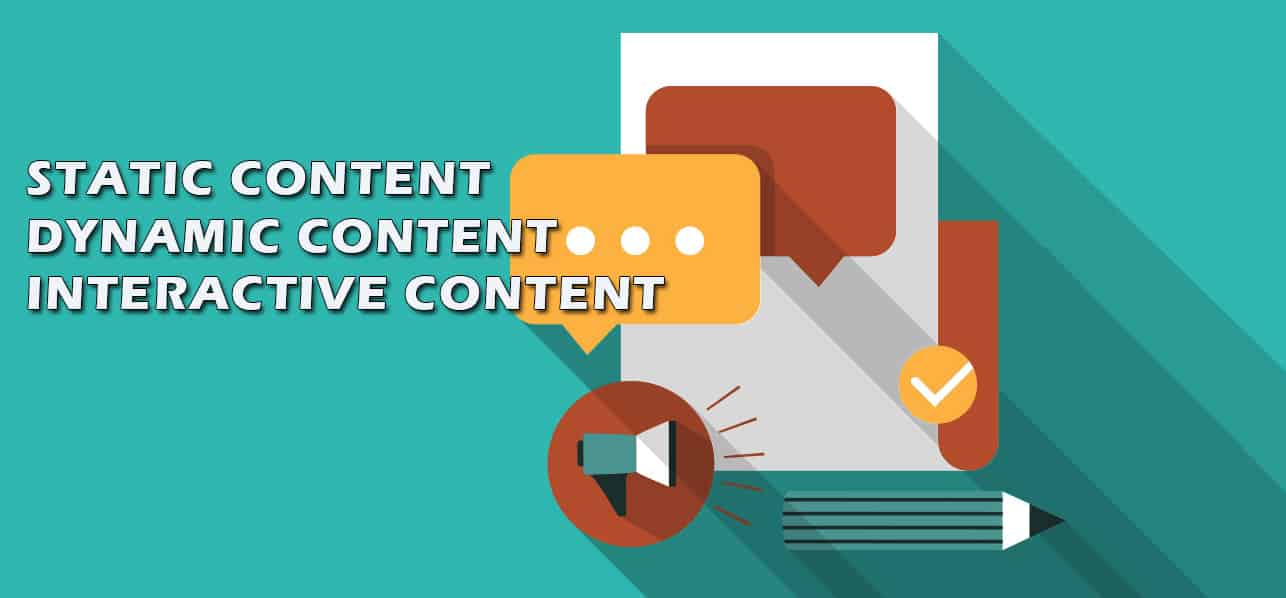Your content marketing strategy often needs to be a steady mix of static, dynamic and interactive content. Yes, content is of different types and every type of content has its own characteristics, and pros and cons. Let’s see how these individual types of content can help you take your content marketing forward.
Static content
Static content never or rarely changes. It remains there on your website for weeks, months and sometimes, even years. It may include your homepage, website pages, eBooks, case studies and white papers, landing pages, videos, PPC campaigns and social media profiles.
Wondering how come videos and social media profiles become static? By static content we don’t mean content that doesn’t move. Although in video things move, but once a video is published, it rarely goes through changes. It is the same story, the same visuals, the same sounds. No matter how many times a person watches your video, it is going to remain the same and eventually, people are going to stop watching it.
Social media/networking profile means the profile, the main page, not the feeds.
Advantages of static content
- Easier to create.
- Easier to distribute.
- Low-cost.
- Lets you focus on highly targeted groups for better conversion.
Disadvantages of static content
- Has no repeat value, people soon get bored of it and stop consuming it.
- Doesn’t get indexed by search engine crawlers repeatedly.
- There is one-way communication with no intent to engage the audience.
Dynamic content
Dynamic content is constantly updated according to the latest trends, available information and user input. Some examples of dynamic content are your business blog, the RSS feeds, your social media feeds, email newsletters, personalised website content (the content changes if a person is logged in or if he or she has become your customer), A/B test landing pages and syndicated content.
Advantages of dynamic content
- It keeps your visitors interested in what you have to say by continuously serving them latest and updated content.
- It gives you higher conversion rate because dynamic content keeps people interested in your website and blog and keeps them coming back to your website repeatedly.
- Interesting, relevant and evolving content increases audience loyalty.
- Dynamic content is shared often on social media and social networking websites.
- It improves your search engine rankings as search engines like Google prefer to visit freshly updated and dynamic content rather than static content that never changes.
Disadvantages of dynamic content
- Dynamic content is costly compared to static content.
- Requires complete change in marketing outlook as all your content becomes customer-centric from product-centric.
- Requires constant analysis because it needs to change and adapt according to its metrics.
Interactive content
As the name suggests, it evolves according to user input. Interactive content is usually not prepared or created by a single person or a single agency and often you have little control over it. Examples of interactive content include your blog comments, people’s comments under your social networking and social media profiles, Facebook updates and tweets, online service, online games and mobile apps, multi-participant webinars, customer reviews and social sharing buttons. Some content marketers also prefer to call it “crowd sourced content”.
Advantages of interactive content
- Low-cost and easy to set up, for example the commenting section on your blog. Similarly, once you create your social networking profiles and start interacting with people and increase the engagement level, people begin to participate in various conversations, generating interactive content in the process. After a certain threshold level, it is practically set on autopilot.
- Gives you more social credibility. If more people are encouraged (feel encouraged) to spend time generating content for you it means they are serious about your brand or at least have some serious views (whether negative or positive). It is a social proof of your online reputation.
- Increases brand loyalty. When people repeatedly interact with you in lieu of generating content for you their sense of loyalty towards your brand increases.
Disadvantages of interactive content
- You have little control over the quality of the content.
- Trolls can easily take over especially on social media and social networking websites.
- Lots of spam can be generated making your entire content marketing counter-productive.
- It can become resource-consuming in the long run because you need to closely monitor the quality of interactions.
What should you focus on? Static, dynamic interactive content?
It depends on your target audience. As mentioned above, it should be a heady mix of static, dynamic and interactive content and all types of content should follow a clearly-defined path of evolution. For example, you can begin your online presence with dynamic content which is needed to create your presence and improve your search engine rankings. Once you have generated decent amount of dynamic content, you should focus on increasing the number of pages containing static content for consistent information. Eventually, as you become more famous on the Internet, interactive content begins to manifest. When this happens, you not only have to keep up with the momentum, you also need to monitor the quality of your interactive content.

